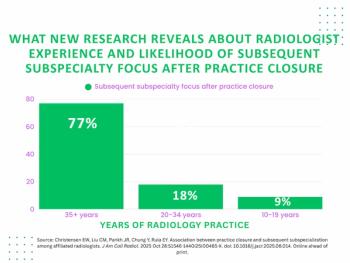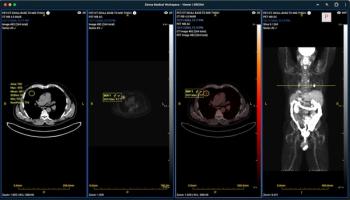
PACS vendors explore managed services model
At first glance, the recent volley of vendor offerings called managed services looks like a reincarnation of the application service provider model popular a few years ago.
At first glance, the recent volley of vendor offerings called managed services looks like a reincarnation of the application service provider model popular a few years ago.
The ASP concept offered hospitals all the benefits of having PACS without the initial capital outlay. Instead, customers contracted a third party to deploy and maintain an appropriate data management, distribution, and storage solution. The idea fizzled somewhat when customers realized the downside to relinquishing control of imaging data to a third party. Not only trepidation over third-party control of archives, but performance as well, became an issue.
"In order to get fast image load times, you often needed enough onsite storage to handle frequently accessed images and priors," said Alan Schweitzer, senior technical manager of professional services at RCG Healthcare Consulting. "As a result, the cost savings were not great, particularly for larger sites."
Recent advances in bandwidth and persistent hospital interest in outsourcing chores like disaster recovery and long-term archiving have prompted a resurrection of the ASP model, this time in the form of managed services.
The two concepts are dissimilar, according to Fujifilm Medical Systems, which announced a managed services package last November. Under an ASP, customers were still responsible for much of the management of the application, whereas Fujifilm and other managed services companies offer management of the application layer, not just the network and hardware.
"This difference enables customers to avoid the need to add full-time equivalent employees to support PACS," said Reynold Yordy, business manager of Fujifilm's Managed Services.
Many smaller healthcare and imaging facilities have limited IT staff.
"Also, we don't just store the data, we manage the storage in terms of disaster recovery and archiving solutions, so customers don't have to," he said.
The managed services approach appeals to institutions wishing to outsource management of disaster recovery and long-term archiving due to the overwhelming amount of data and potential downtime associated with network or server failure. One benefit of managed services is the scale of efficiency and economy that comes from a company whose sole function is storing data. InSite One has archived approximately two billion images for clients.
"We're growing at 17 TB of digital data per week, giving us the ability to purchase storage far less than any radiology, cardiology, or oncology department," said Mitch Goldburgh, an InSite One senior vice president.
Imaging departments are relieved of the worry of technology obsolescence, backup, regulatory compliance, and system availability. Managed services in this iteration also adds features not found in the older ASP models. Fujifilm, for instance, now not only provides disaster recovery and remote archiving, but also offers hosting of RIS and PACS.
"This way, customers are responsible only for the clinical aspects of their environment," Yordy said.
Radiology groups are also trying to move to one centralized work list, review, and reporting platform across all facilities they read for in order to gain efficiency, Yordy said.
"To accomplish this, these groups realize there is a lot of complexity and would prefer to rely on the expertise of others, so that they can concentrate on their expertise, which is interpreting radiology studies," he said.
Clark Warren, vice president of sales and marketing for KJAYA Medical, a provider of real-time interactive multiplanar and 3D reconstructed medical images over the Internet, sees a gradual movement toward scalable centralized image storage, rendering, and distribution solutions. These allow many clients to view images using a cluster of systems instead of one client viewing images with one workstation.
PACS vendors are also beginning to offer pay-as-you-go managed PACS solutions, services that appeal to smaller hospitals, imaging centers, and teleradiology groups.
Managed services in the PACS market are helping make PACS available to small and midsized facilities that could not previously afford to purchase and manage PACS on their own. The solution is becoming so popular, Warren believes that managed services will evolve into the leading form of PACS offering in the U.S. market, driven by teleradiology
"The current growth of teleradiology and the need that rural hospitals and imaging centers have to provide improved healthcare while being able to successfully manage cash flow will propel managed services to the forefront of the market much sooner than later," Warren said.
Vendors offering managed services are able to lower their costs by eliminating the battalion of field engineers currently employed to run support missions from client to client. With managed services, most of the imaging infrastructure previously found in hospitals and radiology centers is now centrally located.
While outsourced disaster recovery services are growing rapidly, there are still some performance limitations associated with remote-hosted PACS, according to Goldburgh.
"If your hospital or imaging center is doing over 50,000 procedures a year, it's probably better to have an onsite server talking to your modalities directly than to run that connection over the Internet," he said. "The question you have to ask yourself is, what risk do you run if your Internet connectivity goes down."
While the current number of sites that have purchased managed services is far from a majority, it is a significant minority. Managed services appeal to larger hospitals looking for ways to develop outreach programs where they provide infrastructure and professional services to smaller hospitals that may refer patients to them for further treatment.
"The challenge with outreach programs is that most larger hospitals have not budgeted the additional capital necessary to fund the FTEs and technology purchases required, so an operational model that is managed for them is attractive," Yordy said.
The managed services model also allows radiology groups to grow their practice while having complete visibility of what technology costs will be for every study they read. Under a managed services scheme, the financial model is generally pay-per-study based on study volume. This approach relieves hospital and imaging group financial planners of guessing at what storage costs will be in an environment in which the average exam size is growing at over 20% each year due to more complex procedures.
"With us, it's storage on demand at a fixed price," Goldburgh said. "It's not per gigabyte, it's per exam."
Newsletter
Stay at the forefront of radiology with the Diagnostic Imaging newsletter, delivering the latest news, clinical insights, and imaging advancements for today’s radiologists.






























